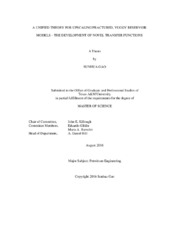| dc.description.abstract | More than half of the world’s oil and gas reserves are found in carbonate reservoirs. Most carbonates are fractured, vuggy reservoirs which can be defined as reservoirs that contain matrix, fractures and vugs. Vugs in such reservoirs can be isolated or connected to a global fracture system. Numerical modeling of naturally fractured, vuggy reservoirs presents many challenges due to the coexistence of three very different media and their complex interaction on multiple scales. With current computing capabilities, conventional fine-scale, single porosity models are not practical for modeling such reservoirs on the multi-well or the field-wide scale due to the massive number of grid blocks. Thus, an effective approach would be through a triple continuum model where matrix, fractures and vugs are separated into three different porosity systems. This work investigates mass exchange between different media with the final objective of providing a unified theory for the use of transfer functions in upscaling fractured, vuggy reservoir simulation models.
In a triple continuum model, the fracture system provides the path for global fluid flow, while vuggy and matrix continua mostly contribute to the fluid storage; thus, the interporosity fluid exchange becomes very important and dominates the oil displacement of such reservoirs. Through the use of fine-grid explicit simulation models, this research analyzed the complex mechanisms of mass transfers between each two porosity systems. Different concept models are generated to show the effect of vug fraction, shape and distribution on oil displacement. New transfer functions for the simulation of 3D two phase fluid flow in the triple continuum model to capture the complex flow mechanisms and emulate the results of the fine-scale, single porosity model are also provided. In addition, a general procedure of incorporating the proposed transfer functions into the triple continuum model along with a novel upscaling technique is presented.
This paper provides the first investigation of the complex fluid exchange among different media in fractured, vuggy reservoirs. Results show that the use of the proposed transfer functions helps to reduce the size of simulation models for fractured, vuggy reservoirs, and improve the computation speed by orders of magnitude, while providing an accurate representation of the fine-scale results. | en |


